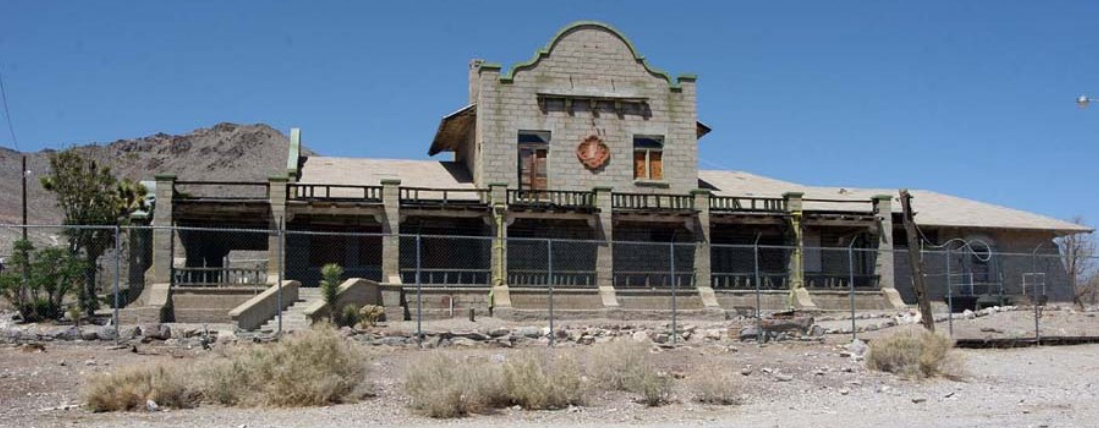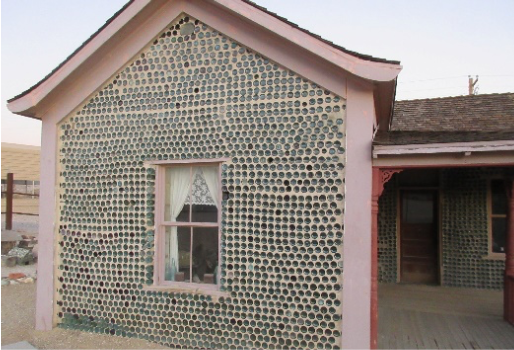Rhyolite was called the “Queen City of Death Valley” and at one time boasted a population of 8000 people. It is now the area’s best-known ghost town. Today you can find several remnants of Rhyolite’s glory days. Some of the walls of the Cook Building are still standing, as is part of the old jail. The train depot and the Bottle House are two of the few complete buildings remaining in the town. Rhyolite is on a mixture of federal and private land. It is not a part of Death Valley National Park but is administered by the Bureau of Land Management. Rhyolite is near Beatty, NV and is 35 miles from the Furnace Creek Visitor Center. A paved road heading north (left) from Hwy. 374 will take you to the ghost town.

Rhyolite’s birth was brought about by Shorty Harris and E.L. Cross, who were prospecting in the area in 1904. They found quartz all over a hill, and as Shorty describes it “…the quartz was just full of free gold…it was the original bullfrog rock…this banner is a crackerjack.” “The district is going to be the banner camp of Nevada. I say so once and I’ll say it again.” Shorty declared. At that time there was only one other person in the whole area: Old Man Beatty who lived in a ranch with his family five miles away. Soon
the rush was on and several camps were set up including Bullfrog, the Amargosa and a settlement between them called Jumpertown. A townsite was laid out nearby and given the name Rhyolite from the silica-rich rock in the area.

There were over 2000 claims covering everything in a 30-mile area from the Bullfrog district. The most promising was the Montgomery Shoshone mine, which prompted everyone to move to the
Rhyolite townsite. The town immediately boomed with buildings springing up everywhere. One building was 3 stories tall and cost $90,000 to build.
A stock exchange and the Board of Trade were formed. The red light district drew women from as far away as San Francisco. There were hotels, stores, a school for 250 children, an ice plant, two electric plants, foundries, and machine shops and even a miner’s union hospital. The town had an active social life including baseball games, dances, basket socials, whist parties, tennis, a symphony, Sunday school picnics, basketball games, Saturday night variety shows at the opera house and pool tournaments. In 1906 Countess Morajeski opened the Alaska Glacier Ice Cream Parlor to the delight of the local citizenry. That same year an enterprising miner, Tom T. Kelly, built a Bottle House out of 50,000 beer and liquor bottles.

In April 1907 electricity came to Rhyolite, and by August of that year, a mill had been constructed to handle 300 tons of ore a day at the Montgomery Shoshone mine. It consisted of a crusher, 3 giant rollers, over a dozen cyanide tanks and a reduction furnace. The Montgomery Shoshone mine had become nationally known because Bob Montgomery once boasted he could take $10,000 a day in ore from the mine. It was later owned by Charles Schwab, who purchased it in 1906 for a reported $2-6 million.
The financial panic of 1907 took its toll on Rhyolite and was seen as the beginning of the end for the town. In the next few years, mines started closing and banks failed. Newspapers went out of business, and by 1910 the production at the mill had slowed to $246,661 and there were only 611 residents in the town. On March 14, 1911, the directors voted to close down the Montgomery Shoshone mine and mill. In 1916 the light and power were finally turned off in the town.
